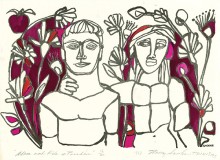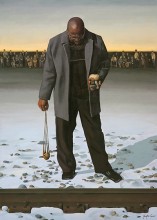Adam and Eve in Paradise by Nancy Snooks
Early in her art studies, California artist Nancy Snooks learned from one of her teachers, Sister Corita Kent, to create drawings without looking down at the paper. What happens in such drawings, says Snooks, is that some elements become exaggerated and others curiously diminished. “Adam and Eve in Paradise” is from her 1969 series of biblically based images. Reflecting on the work, she said she sees in it a couple asking questions: Why am I here? What does God want from me? Why is there suffering? “And also knowing God walks with us—all those insights from Genesis 2.”




